Here is my code
yp = df.final_sulfur/df.start_sulfur
xp = df.mag/df.hm_weight
sns.set(font_scale=1.5, font='DejaVu Sans')
fig, ax = plt.subplots(1,1, figsize=(9, 9))
yp = df.final_sulfur/df.start_sulfur
xp = df.mag/df.hm_weight
p = ax.plot(xp, yp, marker='o', markersize=1, alpha=0.2, linestyle='none')
p = ax.set_xlabel('mag/hm_weight')
p = ax.set_ylabel('final/start sulfur')
p = ax.set_title('final S vs mag')
p = ax.set_xlim(0.08, 12)
p = ax.set_ylim(3.0e-3, 1.5)
p = ax.set_xscale('log')
p = ax.set_yscale('log')
leg = plt.legend()
Trying to fit the curve below is the equation which I think an exponential decay should dobut what I am getting is completely bad result
import scipy as sp
from scipy.optimize import curve_fit
def func(xp, a, b, c):
return a*np.exp(-b*xp) + c
popt2, pcov2 = curve_fit(func, xp, yp, p0=None)
a2, b2, c2 = popt2
print ('a2=', a2, 'b2=', b2, 'c2=', c2)
print ('func=', func(xp, a2, b2, c2))
ax.plot(xp, func(xp, *popt2), 'b-', label='Fit',linestyle='--',color='red')
Note : I need to use log scale for plotting which is when it makes sense
How my sample data looks like (its difficult to put all the data here unfortunately) xp (sample) converted to list for sake of SO
[1.8535530937584435,
0.3220338983050847,
1.184544992374174,
0.7583873696081196,
0.3209681662720337,
1.158380317785751,
1.6285714285714286,
0.44209925841414716,
0.7396205664008799,
0.27983539094650206,
0.575319622012229,
0.3287671232876712,
1.382921589688507,
0.8247978436657682,
1.315934065934066,
0.23450134770889489,
0.5697069296083265,
1.0015731515469324,
1.2841602547094721,
0.645600653772814,
0.4599483204134367,
0.8340260459961208,
0.8992900341835393,
0.961340206185567,
0.5845225027442371,
0.9623773173391493,
1.3451708366962605,
0.8418230563002681,
0.7456025203465477,
1.9345156889495225]
yp [0.05202312138728324,
0.47058823529411764,
0.04833333333333333,
0.11392405063291139,
0.36363636363636365,
0.020588235294117647,
0.008823529411764706,
0.25641025641025644,
0.12,
0.47826086956521735,
0.1826923076923077,
0.3333333333333333,
0.01282051282051282,
0.029411764705882353,
0.03225806451612903,
0.26666666666666666,
0.05,
0.011428571428571429,
0.12080536912751677,
0.11764705882352941,
0.2926829268292683,
0.049999999999999996,
0.06578947368421052,
0.08024691358024691,
0.15517241379310343,
0.024390243902439025,
0.017543859649122806,
0.05479452054794521,
0.03571428571428571,
0.007142857142857143]

